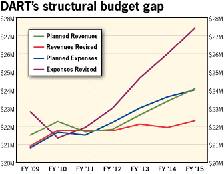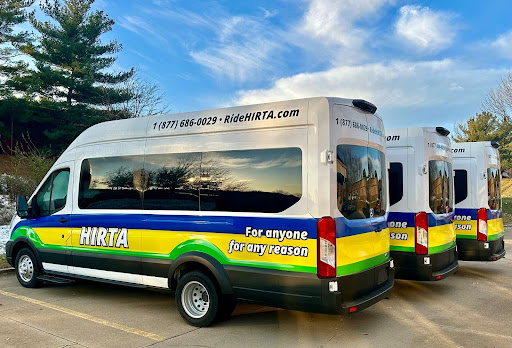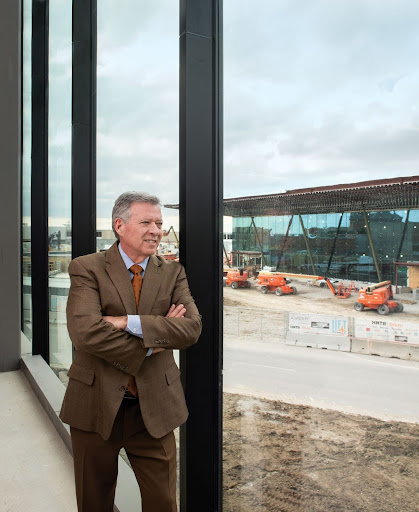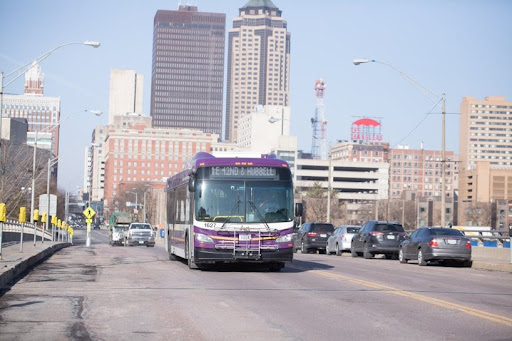DART budget assumptions show potential gap

Brad Miller knows he has a proposition that will be tough but important to sell to cities in Greater Des Moines.
Miller is the general manager of the Des Moines Area Regional Transit Authority (DART), which finds itself in a somewhat unusual position.
Though it faces a potential budget gap of just above $5 million in fiscal year 2015, the bus system has no desire to cut service.
Instead, it wants to expand service in the long term.
“I don’t think anyone is interested in continually cutting service and paying the same rate for less service,” Miller said. “We’re trying to basically switch that equation around, showing and communicating with the communities how we’re going to grow into the future, and if they buy in and remain members of DART, then this is what they’re going to get for their investment.”
To do that, the organization is in the early stages of developing its “DART Forward 2035” plan, which is taking research and rider input to try to come up with a new service model.
The plan is roughly scheduled to be completed by next fall. The plan is not intended to close the budget gap directly, but the two are related. DART officials want to have a plan for the future before asking cities to commit more.
It’s all part of a balancing act. DART has had to cut services by 6 percent in the past year, and has seen a corresponding 12 percent decrease in ridership so far in the fiscal year.
At the same time, the agency got the go-ahead to build a new $21 million transit hub downtown, and has plans to install global positioning system technology on all its buses in 2012, which will give riders an opportunity to know where their next potential bus is at all times.
The projected budget gap takes off between fiscal years 2012 and 2015.
When DART planned the budget assumptions last year, the 2015 projections called for planned expenses and revenues to be nearly even at $24 million. Starting in 2012, revenues and expenses were projected to grow 3 percent annually until 2015.
Now, the 2015 projection for revenues is $22.3 million with virtually no growth due to a decrease in the projected property tax levy. Tax levy money accounts for the highest percentage of DART’s funding at around 30 percent.
Expenses are projected to be $27.4 million – a 5 percent growth rate.
The increase in expenses, Miller said, comes primarily from two sources.
One, the transit hub, though completely paid for by government grants, will require an uptick in the cost of maintenance and customer service staffing.
Two, health insurance rates and Iowa Public Employees’ Retirement System (IPERS) rates for employees are rising.
That leaves two options: Cut service, and therefore expenses, or increase revenues.
DART has opted to try to achieve the latter.
“Fewer people will ride every time we cut,” Miller said.
The long-term projections allow plenty of time to figure out a solution, which is partly where the 2035 plan comes into play.
The plan is in its infant stages, and DART is still gathering data and preparing for customer feedback. The ultimate goal is to come up with solutions to provide more service to increase ridership, and have communities buy in to help fund the cost without increasing fare rates.
An increase in services would likely require an increase in the tax levy, which right now stands at 44 cents per $1,000 of land valuation in Des Moines, second-highest in the DART service area behind Windsor Heights’ 57 cents. DART has the ability to raise that tax but would be foolish to do so without the city’s approval, DART officials say. Instead they must work with cities to sell their vision.
“‘Why should we pay more and get less?’ is sort of a hard question to answer,” Miller said. “I think what is missing in that equation is the plan. … What I’m going to try to turn around with our plan is to say, ‘These are the services we think are needed to get more riders. Are you willing to pay to have these new services and get more riders?’ Hopefully the answer will be yes.”
Miller pointed to a Brookings Institution study that found that Greater Des Moines has the ninth-largest reduction in single-occupancy driving of the top 100 metro areas, whether by riding a bus, carpooling or biking.
He also noted that three communities within DART’s service range – Johnston, Clive and Grimes – have submitted letters to withdraw from DART since the regional system was formed in 2006.
All three rescinded their withdrawal after DART proposed service additions.
Miller said it’s critical to prevent any of the 19 communities with DART services from withdrawing from the system, which is why DART must provide them with a value for their investment, rather than be in a position to take away service.
“I think in general, the public is supportive of public transit and services that make sense,” Miller said. “The services that we’ve implemented on a regional basis, people have chosen to ride. They are riding them. And they are more successful than when we were the (Metropolitan Transit Authority) and each community was on their own to support the service.”
It’s too early to tell what will come of the 2035 plan, but riders should be prepared for service changes, though not necessarily reductions. A big part of the research and feedback is to help decide where routes can best be placed and with what frequency to serve the most riders. For example, Miller said, more emphasis could be placed on suburb-to-suburb service.
Another possibility could be more services like the D-Line downtown shuttle, which recently completed a six-week extension on Friday nights to Ingersoll Avenue that was funded by the Des Moines West Side Chamber of Commerce and the Ingersoll Business Association.











